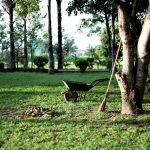Unreasonable budget expectations: Too many people want a BMW yet expect to pay Walmart prices. By establishing a realistic budget up front, expectations can be met from the beginning.Lack of preplanning: Avoid rushing things and not having a plan that looks at the whole project—even if some of the items will be installed later. Learn to trust the process. Design takes time and evolves as the project and designer/client relationship develops.Implementation without a plan: There is so much opportunity lost when each element of a design is thought of singularly as opposed to its place as part of the whole.
Not planning the big things first: A new pool, patio or garage are the kinds of big-footprint items you should plan for first. A common mistake is siting the swimming pool in the middle of the yard and then landscaping around it. This leaves little leftover space for lawn. It’s better to push the pool one way or the other, so there’s room for a chunky-sized lawn that’s good for sports and play.
Not doing your homework when hiring a landscape professional: Don’t hire a designer that you don’t like. Your personalities need to click, as you will be spending a lot of time with this person for the next several months. Check out their background. Are they educated, do they really know the plants, do they know how to problem-solve? Do a drive by on some properties they have designed. If you like the hardscape on each of the projects but the plant selections are weak, keep shopping, as you may not have found your perfect match. If designers are worth their weight, they will be excited that you are interested in their background, client history and getting to know them.
PLANT SELECTION
Improper plant selection and location: Choosing plants that ultimately get too large for the space they are in, or are located in the wrong exposure.
Poor plant choices: Be sure to take into consideration light requirements, water needs and overall plant size. By picking the right plant for your space, you will reduce pruning and fertilizer needs and premature plant replacement.
Buying plants at the nursery by what they look like “right now”: Some of our best desert plants don’t like being in pots and are not all that attractive when you see them at the nursery. However, once in the ground and established, they will be on their way to realizing their full potential. Other plants at the nursery might be bigger and healthier, but they will grow up and mature to 10-foot-high monsters that overwhelm their space. Huge mistake!
Trying to force things to grow that are not compatible with our soils and climate: This is an unnecessary battle. We have so many desert-adapted plants available these days that everyone should be able to find something to create the design effect they desire. It takes a little bit of homework, but the results can be extremely satisfying and low-maintenance.
Not using succulents and native plants: Invasive species, while beautiful, destroy our habitats. Native plants use less water and need pruning less frequently.
Choosing plants that wildlife feast on: Rabbits and other desert wildlife eat many newly planted desert plants. These critters are very thankful that there is little understanding of what they will and will not eat. I frequently see examples of newly installed landscapes becoming lunch for the local wildlife. Develop an understanding of rabbit-resistant plantings, and pay attention to what appears to be left alone in the neighborhood where you live.
PLANTING
Wrong place, wrong plant: Locating shade plants in the sun, and choosing plants that get too large for spaces better suited for dwarf varieties, just won’t work.
Planting designs that have no relation to the natural surrounding areas: For instance, planting bougainvilleas and queen palms in front yards that are surrounded by natural desert. This is unfortunately common in the foothills of the mountains around Tucson.
Not understanding that we have two different growing seasons: There are two seasons in the low desert (cool and warm), and planting the wrong varieties of veggies, annuals and herbs at the wrong time usually results in plant failure.
Over-planting: A dense garden is a thing of beauty, but to pull off that look, proper plant spacing is a must. Situate plants based on their size at maturity. The money you save on buying fewer plants allows you to purchase larger varieties that will fill your garden more quickly. By spacing plants correctly, you can have layers, density and reduced maintenance costs.
Installing thorny plants near sidewalks, driveways or patios: As they grow, their sharp points can stab people. Cutting off the ends of agave, yucca, desert spoon, etc., because they are hazardous ruins their natural shapes. Also, they are difficult to transplant when they get large.
SOIL/FERTILIZER
Not improving poor soil: In a true native landscape, this is not an issue; but for greener gardens, this means plants often are not well-suited to our alkaline soil. Proper soil amendments and fertilizer will help with this.
Using the wrong types of fertilizer at the wrong time of year: At the very least, use water-soluble fertilizers. What may look like salt burn is usually a lack of certain nutrients in the soil that allows plants to properly take in fertilizer.
WATERING
Improper watering: This generally is considered the No. 1 cause of plant health problems. Poor irrigation practices stress plants (maybe to death), and stressed plants are more susceptible to disease and insect problems.
Bad irrigation systems: One irrigation valve should not water everything. Irrigation stations should be installed based on the type of plant (tree, shrubs, pots, etc.).
Too much water: Over-watering native drought-tolerant plants is one of the quickest ways to kill them.
No consideration for drainage and how water moves across the landscape: A landscape should be designed so that water moves away quickly or is harvested in small depressions in the ground.
Over-watering low-water-use container plantings: It’s tempting, but this is the road to ruin. Cacti and succulents have adapted to brief, infrequent waterings. Succulents have waxy surfaces that help them retain what little water they need. Just because you’re sweaty and thirsty and could use a tall glass of water, doesn’t mean your desert plants could, too.
A bad drainage system: Every yard has different drainage issues, and in many cases the drainage is poor at best. The key to solving most water issues is to understand how a drip system works and why it can be so effective in watering in our hard-soil conditions. The basics would be a proper irrigation setup and proper irrigation system maintenance, such as checking for clogged or missing drip heads. I always tell people before they plant anything to fill the hole they are planting with water. If the water is gone in 30 minutes, they have good drainage. If hours later the water is still there, drainage is poor.
TREES
Poor tree placement: Planting trees too close to the house doesn’t allow room for their roots and branching structure to grow properly.
Planting trees in your lawn: Tree canopies create uneven sunlight, which creates uneven grass growth, which makes maintenance difficult.
Buying trees that are huge and grow fast, and are then placed in the smallest spots: This just turns into a nightmare of breaking branches, falling trees, etc. Pick a smaller, slower growing tree to work in tight areas. While this type of tree may take a few years longer to reach maturity, you won’t have to remove it or have the monsoons do it for you.
Buying trees that can’t stand on their own: Ask nursery staff to remove the plant stake before purchase. If the tree stands tall, staking after transplant isn’t needed, unless conditions are extremely windy. Research shows that slight movement that an unstaked trunk experiences helps it grow stronger and gain girth.
Flat-topping trees to reduce their height: Bad, bad, bad. If you want something small, consider an ornamental tree or large shrub. I have seen amazing purple plums, pittosporum, Myrtus, and Mediterranean fan palms that mature at 15 feet and need almost no pruning to maintain their size.
Buying trees that look perfect right now: Wrong. You need to buy trees that are growing up and have strong vertical lines. Over the years they open up, and the branches will be lower and the shape will be perfect.
Not moving water emitters as a tree grows: Ever stand under an oak tree when it rains? It is always dry. The roots that absorb water are at the edge of the tree to collect all the water running off the canopy. I am sure that this evolved so that the trees would be stronger and better rooted to withstand wind. To protect your trees from monsoon rain and winds, move the emitters annually. What you spend in extra maintenance will surely be less than replacing a specimen tree.
LAWNS
Planting grass in shady areas: Shade and grass do not go well together in the low desert and, unfortunately, there are no good options for grass varieties that will grow here in the shade.
Planting grass in areas that will be impossible to water efficiently: This includes street medians or narrow strips along sidewalks, as sprinklers often spray water into the street.
MAINTENANCE
Improper pruning of plants: Mother Nature didn’t intend plants to be shaped like soup cans!
Poor gardening practices: Pruning Texas sages into balls; saguaro “torture” (planting them where they don’t have room to grow); placing plastic under gravel in planting beds, which doesn’t allow the rain to soak in; and thinking a low-maintenance landscape means NO maintenance.
Spraying pesticide indiscriminately: This is often done without first identifying the pest or disease problem accurately.
Not protecting plants during freeze warnings: Be sure to cover plants and trees at the first warning of a freeze with a sheet, blanket or landscape cloth, never plastic. If your plant is damaged by frost, avoid the urge to remove the damaged parts immediately. It is best to wait until spring to trim any damaged leaves and branches, as those areas will protect the living parts from further damage should a freeze occur again.
DESIGN
Plopping boulders on the ground: You just don’t see much of that in a natural landscape.
Failure to include out-of-sight storage: Garbage bins, garden tools and other “stuff” can make an otherwise nice garden look junky and cluttered. It’s a problem that’s easy to rectify with screens or evergreen plants.
Overlooking privacy issues: What goes unnoticed but is critically important to a beautiful backyard literally is what you don’t see. Unless you live on a lake or a golf course, build your walls as high as possible, and plant trees to block views to your neighbors.
Poor planning: Building patios that are not sloped in the right direction for rain runoff. Also, designing front yards without focal points.
Making patio spaces too small: 12’ by 12’ minimum. Why? Twelve is a magic number because, like a dining room, it’s enough space for a table and chairs plus room to get by. 10’ by 10’ is doable but tight. Always think in terms of where furniture will go. Chaise lounges or club chairs with ottomans need 10’ minimum.
Thinking too small: Instead, think big! Don’t use lots of small plants or cacti—less but important can be better.
Too much clutter: A garden can get like a hall closet if you don’t watch out, with lots of little ornamental things like stacks of tiny terra-cotta pots. Not everything that everyone ever gave you needs to be displayed. Learning to edit can be instantaneously gratifying. The easiest solution: Take all of your pots, wind-spinners, ceramic statues, howling coyotes and all accessories, and stack them out of your visual playing field. Then give yourself one day; wake up and see your space with zero clutter. Add back in only the stuff that makes your heart sing.
Placing the barbecue too far away: It’s best to place it as close to the indoor kitchen as possible. People tend to use their barbecues in direct correlation to how far they have to carry food and dirty dishes. Also, you need durable, easy-to-clean counter space for food prep and a buffet. Stainless steel and concrete are always good. Other more decorative surfaces (like some tiles, granite) have all the same staining issues as in the kitchen, plus they are exposed to the elements.









